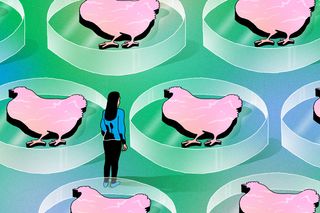
From 3D‑Printed Food to a Meal‑In‑A‑Pill: How Viable is the Future of Food?
Growing interest in alternative foods may force us to choose between nutrition and taste.

In The Future Of, we unpack technology’s growing influence on our lives to answer the pressing question — What lies ahead?
In January 2023, house crickets and the maggot-like larvae of lesser mealworms made it to the European Union’s list of approved insects to be sold as food for humans. This comes against the backdrop of climate change, rising global food insecurity, and serious concerns over what the world’s population will eat in the future when crops fail and resources are scarce. Experts agree that our food production systems are highly unsustainable and a major cause of rising greenhouse gas emissions. Food production and consumption face massive challenges – certain parts of the world see large amounts of food wastage, while in other regions there is widespread malnutrition. Alternative food sources are thus receiving considerable attention today for being able to account for people’s nutritional needs while also helping tackle the climate crisis.
Insects, for instance, are nutrient rich, while farming them involves only a small fraction of the land and resources required for the emissions-intensive meat and dairy industry. Edible insects are packed with protein, earning them the coveted status of “superfoods.” Eating insects is a centuries-old practice that still prevails in countries across Asia, Africa, and South America. However, the thought of consuming them continues to make people squirm with disgust, particularly in the West, forcing the European Commission to issue a clarification: “Nobody will be forced to eat insects.”
Diversifying our diets to include novel foods is not the only proposed solution. There is considerable innovation taking place in the food and nutrition field, including the integration of technology in food systems.
“At the end of the day, you might have the healthiest, most nutritional, most sustainable product but unless it tastes nice and people are willing to accept it, it may be a lot more difficult to get that across,” Chef Andy Holcroft, who started the UK’s first edible insect restaurant, told BBC Future.
Advancements in food technology are thus attempting to ensure that the taste and texture of future foods closely mimic real foods. Impossible Foods, for example, became the first company to make a plant-based burger “bleed” in an effort to create the illusion of real beef.
The poster child of food tech, at present, is cultivated meat, also known as cultured or lab-grown meat – a meat substitute that is grown from animal cells in bioreactors and is considered to be a more sustainable option for meat-eaters. Investments have poured in and the lab-grown meat industry has dominated headlines for its ability to reduce both the slaughter of animals for consumption and the negative environmental impact of traditional meat production.
Bringing lab-grown meat to markets still poses several challenges, however, with affordability and scalability rendering lab-grown meat’s commercial viability impractical at present. Questions have also been raised about claims regarding lab-grown meat’s safety, sustainability, and ethics.
Shifting food production from the farm to the lab may also consolidate control over the food system in the hands of for-profit companies, sidelining smallholder farmers across the world. Will technology’s integration in the food sector then help address the inequalities in food production and consumption or exacerbate them?
Related on The Swaddle:
A Startup Could Soon Sell Lab‑Grown Meat in the U.S.
3D-printed food
The hype around 3D printing has now extended to the food industry as well, with machines printing food using fresh ingredients. Some even envision a future where 3D printers are a common fixture in all kitchens, becoming as ubiquitous as a microwave. This technology is said to have several advantages, provided all food safety and sanitization standards are followed and costs are eventually lowered to allow for widespread adoption.
For one, it could drastically reduce food waste. According to the UN, 17 percent of total global food production goes to waste. Two researchers at the University of Florida believe these wasted food products could be used to print edible tableware, where a “viscous substance” like mashed potatoes could be shaped, cooked, and used to serve food. This cuts out the need to wash dishes after a meal, reducing the economic and ecological costs of food wastage.
Another important application of food printing comes with its ability to play with texture and offer a high degree of customization to cater to individual preferences.
For elderly people or those suffering from dysphagia or difficulty swallowing, for instance, food printing could modify the texture. Smoothfood by Biozoon deconstructs food into its basic elements, strains and purees it, before reconstructing it to assume its original shape. In Germany, this approach was adopted for the elderly in around 1,000 retirement homes.
As Jason Ong Xiang An noted in Part 1 of Future Typologies, this technology can use liquified vegetables, meat, and carbohydrates as the printing material, ensuring adequate nutritional intake that moves away from packaged, processed food. Even the micronutrients and calories can be personalized to cater to individual dietary requirements.
Food tailored to our DNA
The link between our dietary choices and health have birthed a number of guides that outline what a balanced, nutritious meal looks like. However, each body reacts differently to food based on genetics, environment, and even the microbes colonizing our gut.
“The $66 billion diet industry, which churns out new diet books every day, is proof that many people haven’t found success with one-size-fits-all approaches,” said Neil Grimmer, founder and CEO of Habit, a personalized nutrition company.
With the emerging field of nutrigenomics, scientists believe we will be able to tailor our diets to our DNA. To a certain extent, this is already taking place in the US with companies such as DNAFit offering personalized nutrition advice based on one’s genetic makeup, which is determined through at-home DNA testing kits. Others, such as GUTXY, assess one’s gut microbiome to decode the right diet. Personalized nutrition then follows the “food as medicine” approach.
However, there are others who are skeptical of the claims of personalized nutrition companies, expressing doubt over how much of our nutritional needs actually depend on our genes. The PREDICT study – the world’s largest scientific nutrition study – evaluated the rise and fall of parameters such as blood glucose and fats in 700 identical twins and 400 non-twins to determine individual responses to food.
“If these differences are genetically driven, then we would expect the identical twins to respond similarly. But they didn’t. Genetics appeared to account for less than a third of the subjects’ insulin and triglyceride responses,” nutritionist Monica Reinagel wrote in Scientific American. The findings suggest that there are several other factors at play here, including hours of sleep, exercise, stress levels and gut microbes.
Opting for personalized nutrition testing also places one’s genetic data in the hands of companies that are not governed by the same privacy standards as healthcare providers, noted the Food Technology magazine. There is a substantial risk of such private data being sold to third parties or being used for reasons not approved by an individual.
Further, such hyper-personalization of diets may not be an option for everyone. In a world where 1.9 billion adults are overweight while 462 million are underweight, such an approach to improving nutritional intake is likely to remain restricted to developed countries. “This is a First World technique. It is aimed at educated, well-off people who are already healthy but want to be healthier,” said Marion Nestle, a professor of nutrition at New York University.
Related on The Swaddle:
What Would a Million People on Mars Eat? GMOs and Maybe Bugs
Meal-in-a-pill
When it comes to the future of food, the concept of a meal-in-a-pill has been a staple in the science-fiction diet – popularized by several works, including The Jetsons and the musical Just Imagine. The idea is in line with futuristic visions of a world where efficiency and convenience trump all.
The science, however, is nowhere close to creating meals-in-pills. An noted that meal-replacement pills don’t exist yet because it is incredibly difficult to pack all caloric and nutrient needs into a single capsule. An average adult needs 2000 calories a day. To meet these requirements, people would be required to consume not one but around 450 pills a day. This still leaves out other micronutrients, proteins, and vitamins necessary for human health, which could lead to deficiencies or even malnutrition. “Therefore, till date, meal replacement pills are not a viable, sustainable and a long-term solution as compared to conventional food.”
Despite this, entrepreneurs continue to experiment and even come close with meal-replacement powders and supplements. Of these, Soylent’s original meal replacement powder – a thick shake that reportedly packs all the nutrition one needs into a single, albeit “bland” drink – received widespread attention after its arrival, especially in Silicon Valley.
“We’re trying to be pragmatic here. People aren’t going to eat well all the time… You need a lot of knowledge – all these details that go into eating healthily – and we’re trying to automate it,” Rob Rhinehart, then-CEO of Soylent, told CNN in 2013. Rhinehart, at the time, claimed that Soylent could also end world hunger. Powdered meals are often used by international aid organizations in poor countries to battle hunger and malnutrition. However, Soylent’s price still remains unaffordable for many living in poverty.
Chris Ziegler, who tried living on Soylent for a month, wrote, “[T]he real problem is that Soylent ignores the social and entertainment value of eating: food is not merely sustenance, it’s a tightly woven part of our everyday lives… A strict diet of beige liquid fundamentally changes the patterns of your daily life, and not entirely for the better. It isolates you in ways you may not necessarily consider.”
Even with other alternative foods such as microalgae, innovators are working on making them more palatable to tastebuds unfamiliar with their flavor. In an article worryingly titled “The Future is Flavorless,” Alison Sinkewicz wrote, “The question of pleasure, and suppressing it for a greater goal, is often brought up in connection to these futuristic, high-concept foods… It also motions to a larger cultural challenge to address the racial dynamics of food. Who gets to determine what tastes good?”
While technology, when working in tandem with traditional practices, can offer several benefits to transform our food systems, most tech-enabled alternative foods are currently impractical for a world battling the intersectional issues of hunger and poverty. Even if they become commercially available, they will remain restricted to ultra-niche fine dining for now.
While data is being integrated into agricultural systems and AI-algorithms are personalizing nutrition, Nick Jacobs, the Director of the International Panel of Experts on Sustainable Food Systems, wrote, “The Big Tech agenda is built on the same power imbalances, social inequalities, and hidden costs (or “externalities”) that are rife in today’s food systems, and is fundamentally disconnected from local contexts and needs.”
Without addressing these system-borne issues, advancing access to nutritious food for all may remain a significant challenge in the future.
Ananya Singh is a Senior Staff Writer at TheSwaddle. She has previously worked as a journalist, researcher and copy editor. Her work explores the intersection of environment, gender and health, with a focus on social and climate justice.
Related


Faster, Non‑Invasive Endometriosis Tests Are Finally in the Horizon
